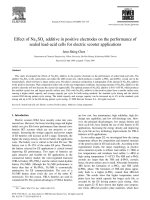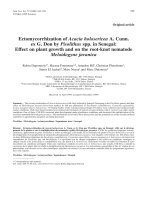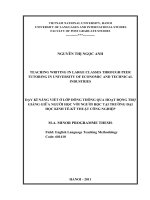- Trang chủ >>
- THPT Quốc Gia >>
- Sinh học
Effect of non-polar bioactive molecules of tagetus on second stage larvae of meloidogyne javanica in lab conditions - Trường Đại học Công nghiệp Thực phẩm Tp. Hồ Chí Minh
Bạn đang xem bản rút gọn của tài liệu. Xem và tải ngay bản đầy đủ của tài liệu tại đây (186.26 KB, 7 trang )
<span class='text_page_counter'>(1)</span><div class='page_container' data-page=1>
<i><b>Int.J.Curr.Microbiol.App.Sci </b></i><b>(2017)</b><i><b> 6</b></i><b>(11): 3484-3490 </b>
3484
<b>Original Research Article </b>
<b>Effect of Non-Polar Bioactive Molecules of </b>
<i><b>Tagetus</b></i>
<b> on Second Stage </b>
<b>Larvae of </b>
<i><b>Meloidogyne javanica</b></i>
<b> in Lab Conditions </b>
<b>Abhilasha Srivastava* </b>
Department of Science and Technology, New Delhi, India
<i>*Corresponding author </i>
<i><b> </b></i> <i><b> </b></i><b>A B S T R A C T </b>
<i><b> </b></i>
<b>Introduction </b>
Chemical control of plant-parasitic nematode,
essentially, involves the use of synthetic
nematicides. As we know that nematodes are
microscopic pathogens and create heavy loss
in crop yield. Root-knot nematodes are
sedentary endoparasites and most damaging
agricultural pests, attacking a wide range of
crops. The infection starts with root
penetration of second stage juveniles (J2)
hatched in soil from egg encapsulated in egg
masses laid by females on the infected roots.
Nematode infestation is considered as a prime
constraints in realizing optimum yield
potential of cultivated crops causing
approximately 15-20% yield losses.
India produced 78.2 million tonnes of
vegetables from 5.73 million hectare of land.
Tomato is one of the important and popular
vegetables grown in India and other parts of
the world. It is a rich source of soluble sugars,
several organic acids (Citric and Malic acids),
<i>International Journal of Current Microbiology and Applied Sciences </i>
<i><b>ISSN: 2319-7706 Volume 6 Number 11 (2017) pp. 3484-3490 </b></i>
Journal homepage:
An experiment was conducted under laboratory conditions in petri-plates, to study the
effect of bioactive molecules extracted from roots and aerial parts of Tagetus plant on
<i>Meloidogyne javanica</i> (second stage larvae) which forms root-knot in various crop plants
and create severe loss. For its efficacy evaluation, the extracted compounds, initially the
extracted fractions were converted into suitable E.C. (emulsified concentration)
formulations and prepared formulations were tested against second stage larvae of
<i>Meloidogyne javanica</i> under lab conditions. Solvent used for isolation were hexane(A),
dichloromethane(B), ethyl acetate(C), acetone(D) and methanol(E), in which the first three
solvents were non-polar in nature. The activity of EC formulations developed separately
by isolated fractions A, B, C, D and E of Tagetus plant biocidal compounds varied
according to compound doses and time of exposure. A great difference, in all respect, in
the toxicity of all the developed formulations was observed. Results clearly indicates that
the formulations developed from non-polar fractions exhibited severe impact on mortality
and paralysis of second stage juveniles of <i>Meloidogyne javanica</i> in comparison to the
formulations developed from polar fractions. But results indicate that the maximum
mortality rate between the non-polar fractions were present in hexane soluble compounds.
So, it is clear that maximum mortality rate was present in highest non-polar compound and
followed by less non-polar compounds. The paper deals with the study of the effect of
three different, non-polar compounds fractionated at different levels of polarity and their
impact on juveniles.
<b>K e y w o r d s </b>
Allelochemicals,
Allelopathy, Tagetus,
<i>Meloidogyne javanica, </i>
Solvents,
Biopesticides
</div>
<span class='text_page_counter'>(2)</span><div class='page_container' data-page=2>
<i><b>Int.J.Curr.Microbiol.App.Sci </b></i><b>(2017)</b><i><b> 6</b></i><b>(11): 3484-3490 </b>
3485
Mineral salts and large quantities of Vitamins
A, B2 and C. The vegetable is attacked by
root-knot nematode. In India, reduction in the
yield of tomatoes due to root-knot nematode
has been reported 26.5 to 73.3%. The
management of this nematode has been
carried out by several workers (Akhtar and
Mahmood, 1993; Das and Mishra, 2003;
Dwivedi <i>et al.,</i> 2004; Gaur and Prasad, 1990).
So, it is the necessary to control these tiny,
harmful worms in field conditions. However,
apart from very high cost of chemical
pesticides, increased concern for the
environment has necessitated a reduction in
amount of nematicide used for nematode
control. Additionally, there has been an
increase in the intensity of search for other
efficient, ecologically sound and safe control
methods.
<i>Tagetus </i>is an ornamental plant. It has several
pesticidal properties in which nematicidal
activity is well known in field conditions. We
are using this plant as green technology which
is safe for environment and easily available in
our country. Total work is in the direction to
extract particular potential molecules from
plant which will be the pin-point for the
mortality rate of second stage larvae of
<i>Meloidogyne javanica </i> in field conditions.
Allelochemicals refer mostly to the secondary
metabolites released by intact live plant into
their surrounding and are by product of
primary metabolic process. Different classes
of allelochemicals e.g. phenolic acids,
caumarins, flavonoids, terpenoids, alkaloids
and sulphides etc. have been identified.
Allelopathy has direct (toxicity) or indirect
(i.e. by supporting growth of biocarbon
agents) effect on pests.
<b>Materials and Methods </b>
Plant of <i>Tagetus </i>has been grown in a trapping
system, which was developed with the help of
Butchner funnel of 110 cm diameter and
conical flask of 500ml. capacity. The sieve
plate of buchner funnel has been cut and
firstly muslin cloth was placed in it, then
funnel was filled with the soil (loamy soil) of
field capacity. The 2-3 seeds of <i>Tagetus</i> were
grown in every trapping system. After the
seedling growth when plants attained some
height one plant was allowed to grow and
other was thinned. After attaining the maturity
(at the time of flowering) plant was taken out
from the system and shade dried. After that
the roots were cut into small pieces and
powdered. Then it was processed for the
recovery of biocidal compounds.
Firstly, known quantity of the material was
mechanically stirred in required solvent
system for 2-3 hours at room temperature and
then filtered. Filtrate was evaporated to
minimum amount under vacuum at 50OC
1OC. The concentrated solution was
transferred to a separating funnel and
partitioned with some amount of ethyl acetate
and hexane. The mixture was vigorously
shaken for two hours and kept overnight to
settle the different layers. By this
allelocompounds got fractionated into two
major groups (a) Polar (Which remained with
H2O layer) (b) Non-polar (Settle down with
ethyl acetate layer).
</div>
<span class='text_page_counter'>(3)</span><div class='page_container' data-page=3>
<i><b>Int.J.Curr.Microbiol.App.Sci </b></i><b>(2017)</b><i><b> 6</b></i><b>(11): 3484-3490 </b>
3486
<b>Analysis of compounds </b>
<b>Thin layer chromatoraphy method</b>
TLC methods were developed to analyze and
checking the purity of the isolated compounds
of <i>Tagetus</i> root exudates present in each
fraction.
After that bioefficacy of extracted compounds
were evaluated against second stage of
juveniles of <i>Meloidogyne javanica </i> in the
laboratory and in pots on Tomato plants.
For bioefficacy evaluation initially the
emulsified concentrations of the extracted
fractions were converted into suitable
concentrations.
EC formulations of different concentrations
were tested against the second stage juveniles
for which cultures were maintained in the
laboratory of the Department of Botany,
P.P.N. College, Kanpur on Chickpea and
<i>Sisbanea </i>spp.
<b>Preparation of EC Formulation </b>
For bioassay study initially the isolated
compounds were converted into suitable EC
and EW formulations. Non-polar i.e. hexane,
ethyl acetate and acetone soluble fractions
were emulsified separately at 10%
emulsifiable concentrate (EC) by taking the
required quantity of products and adding them
(10%) tween 80 as emulsifier and 80%
xylene. ECs were obtained by constantly high
speed agitating the mixture for two-three
hours.
<b>Preparation of Test Solution </b>
Test solutions of different concentrations
were prepared by taking the appropriate
amount of EC diluting it in a definite volume
of water.
<b>Formula </b> <b>used </b> <b>for </b> <b>preparation </b> <b>of </b>
<b>concentration </b>
The amount for each experiment was decided
on the basis of following formula:
ai required in Test solution x
Volume of solution
Amount of EC = ---
% ai in formulation
<b>Bioassay Test </b>
Second stage juveniles (J2) of root-knot
nematode were allowed to hatch from egg
masses obtained from culture maintained on
Chick pea in Dept. of Botany, P.P.N. College,
Kanpur in earthen pot.
Experiments for bioefficacy evaluation of
extracted compounds were conducted on
freshly hatched second stage juveniles in
petriplates of 12 ml.
Capacity, 9 ml. distilled water was poured in
each petriplate and with the help of
micropippette desired quantity of
formulations were added and mixed well.
One ml. of suspension of freshly hatched
larvae were added to each petriplate and that
make the total volume of water of 10ml. and
plates were loosely caped by another
petriplates and were kept for 24, 48 and 72
hours at room temperature (30O + 1OC).
All treatments were replicated thrice. A set of
control was also placed containing only
xylene and tween-80.
</div>
<span class='text_page_counter'>(4)</span><div class='page_container' data-page=4>
<i><b>Int.J.Curr.Microbiol.App.Sci </b></i><b>(2017)</b><i><b> 6</b></i><b>(11): 3484-3490 </b>
3487
<b>Results and Discussion </b>
<b>Recovery </b> <b>and </b> <b>Purity </b> <b>of </b> <b>biocidal </b>
<b>compounds </b>
Approximately 2kg of <i>Tagetus </i> roots were
processed for the recovery of biocidal
compounds of different category viz. polar
and non-polar category. A total of six
different fractions named as A, B, C, D, E and
F as per their clear-cut solubility in different
polarity of solvents viz. hexane,
dichloromethane, ethylacetate, acetone,
methanol and water were recorded. TLC
methods were developed to analyze the
extracted fractions for their exact purity and
total number of compounds present in each
fraction. Silica gel of TLC grade was
observed to be the appropriate coating
materials for non-polar compounds. Highly
non-polar compound hexane soluble
compound resolved best in n-hexane while
ethyl-acetate compounds resolved in 60: 40
n-hexane and ethyl-acetate mixture. All
fractions were found more than 90% pure as a
single compound as per TLC analysis.
<b>Effect on juveniles </b>
The activity of EC formulations developed
separately by isolated fractions like A, B and
C of <i>Tagetus </i> root exudate biocidal
compounds varied according to compound
doses and the time of exposures obtained
observations are revealed in table 1-3. A great
difference, in all respect, in the toxicity of all
the developed formulations was observed.
Results clearly indicated that formulations
developed from non-polar fractions exhibit
severe impact on the mortality rate and
paralysis of second stage juveniles of
<i>Meloidogyne javanica</i>. But in between three
of non-polar compounds maximum juveniles
mortality rate at different exposure times was
achieved by the formulations developed from
highly non-polar fraction i.e. hexane (A,
Table 1) followed by ethylacetate and acetone
(B, C Table 2 and 3). Emulsion concentrate
formulation developed from less non-polar
fraction was found practically least effective
at the same concentration and at maximum
time of exposure (72 h).
Results indicate that the polarity of the
extracted compounds of <i>Tagetus</i> root exudate
remained as the key factor in imparting the
toxicity against second stage juveniles of
<i>Meloidogyne javanica</i>.
Results also indicate that as the polarity of
solvent changes from non-polar to polar even
every high concentration is not much
effective in comparison of non-polar
compounds.
<b>Table.1 </b>Effect of hexane soluble compounds
Conc.
g ml-1
Percentage mortality
after 24 hours.
Percentage mortality
after 48 hours.
After 72 hours.
A1 A2 A3 Aver A1 A2 A3 Aver A1 A2 A3 Aver
25 3 3 4 3.3 8 10 8 8.7 15 18 20 17.6
</div>
<span class='text_page_counter'>(5)</span><div class='page_container' data-page=5>
<i><b>Int.J.Curr.Microbiol.App.Sci </b></i><b>(2017)</b><i><b> 6</b></i><b>(11): 3484-3490 </b>
3488
<b>Table.2 </b>Effect of ethyl acetate soluble compounds
Conc.
g ml-1
Percentage mortality after
24 hours.
Percentage mortality after
48 hours.
After 72 hours.
A1 A2 A3 Aver A1 A2 A3 Aver A1 A2 A3 Aver
25 3.0 4.2 4.0 3.7 7.5 8.2 7.1 7.6 9.0 10.4 8.8 9.4
50 6.0 7.2 6.0 6.4 11.0 14.8 12.4 12.7 15.0 18.2 16.0 16.4
100 27.2 32.0 28.0 29.6 48.0 52.4 46.3 48.9 50.2 63.0 64.0 59.6
150 50.0 52.5 53.5 52.0 73.0 78.2 72.0 74.4 84.3 82.3 80.2 82.3
200 98 100 100 98.7 100 100 100 100.0 100 100 100 100.0
<b>Table.3 </b>Effect of acetone soluble compounds
Conc.
g ml-1
Percentage mortality
after 24 hours.
Percentage mortality
after 48 hours.
After 72 hours.
A1 A2 A3 Aver A1 A2 A3 Aver A1 A2 A3 Aver
100 7 10 7 8.0 9 11 8 9.3 15 18 20 17.7
200 12 12 15 13.0 14 15 15 14.7 27 29 24 26.7
300 28 45 42 38.3 32 45 42 39.6 35 48 45 42.7
400 39.0 38 32.2 36.4 44 48 40 44 50 51 44 48.3
500 36.2 49 34.8 40.0 42 56 46 48.0 48 58 50 52.0
600 42.0 45 50 45.6 53 55 60 56 60 60 62 60.6
700 59 55 52 55.3 70 76 76 74 73 78 76 75.7
<b>Bioefficacy of Merigold Root's biocidal </b>
<b>Compounds Effect of Hexane Soluble Compounds </b>
0
20
40
60
80
100
120
A1 A2 A3 Aver A1 A2 A3 Aver A1 A2 A3 Aver
<b>Percentage Mortality </b>
<b>C</b>
<b>o</b>
<b>n</b>
<b>c</b>
<b>. </b>
<b>u</b>
<b>g</b>
<b> m</b>
<b>l</b>
<b>-1</b> 25
</div>
<span class='text_page_counter'>(6)</span><div class='page_container' data-page=6>
<i><b>Int.J.Curr.Microbiol.App.Sci </b></i><b>(2017)</b><i><b> 6</b></i><b>(11): 3484-3490 </b>
3489
The results suggest that the biocidal
compounds extracted from the <i>Tagetus</i> root
especially the non-polar group of compounds
possess molecules with tremendous
nematicidal activity, which can be utilized
effectively as a new control strategy with
minimal or nil environmental impact for
effective control and management of
<i>Meloidogyne</i> spp. and possibly other
nematodes in agricultural and other important
commercial crops. In all directions emulsion
concentrate formulation developed from
<b>Effect of Acetone Soluble Compounds</b>
0
20
40
60
80
100
A1 A2 A3
Ave
r
A1 A2 A3
Ave
r
A1 A2 A3
Ave
r
<b>Percentage Mortality </b>
<b>C</b>
<b>o</b>
<b>n</b>
<b>c</b>
<b>. </b>
<b>u</b>
<b>g</b>
<b> m</b>
<b>l</b>
<b>-1</b> <sub>100</sub>
200
300
400
500
600
700
<b>Effect of Ethylene acetate soluble compounds </b>
0
20
40
60
80
100
120
A1 A2 A3 Aver A1 A2 A3 Aver A1 A2 A3 Aver
<b>Percentage Mortality </b>
<b>C</b>
<b>o</b>
<b>n</b>
<b>c</b>
<b>. u</b>
<b>g</b>
<b> m</b>
<b>l</b>
<b>-1</b> 25
</div>
<span class='text_page_counter'>(7)</span><div class='page_container' data-page=7>
<i><b>Int.J.Curr.Microbiol.App.Sci </b></i><b>(2017)</b><i><b> 6</b></i><b>(11): 3484-3490 </b>
3490
highest non-polar compounds was found most
effective at the same concentrations in field
conditions.
After lab experiments, all the results indicate
that the polarity of extracted compounds of
<i>Tagetus</i> root exudates remained as the key
factor in imparting the toxicity against second
stage of juveniles of <i>Meloidogyne javanica</i> in
lab conditions Therefore, the formulations
developed especially from non-polar fraction
hexane was found detrimental to the juveniles
and Root Galls.
The results suggested that the biocidal
compounds extracted from the <i>Tagetus </i>root,
especially, the non-polar group of compounds
posses molecules with tremendous
nematicidal activity, which can be utilized
effectively as a new control strategy with
minimal or nil environmental impact for
effective control and management of
<i>Meloidogyne</i> spp. and possibly other
nematodes in agricultural and other important
commercial crops. It will also curtial the
budget of chemical pesticides.
<b>Acknowledgement </b>
I am thankful to department of Science and
Technology for their financial assistance and
the Principal and Head of the Department of
Botany, P.P.N. College, Kanpur for providing
the infrastructural and reprographic facilities
during the course of this study.
<b>References </b>
Akhtar, M. and Mahmood 1, 1993. Control of
plant parasitic nematode with Nimin
and some plant oil by bare root dip
treatment. Namat Medit., 21: 89-92.
Das, Dibakar and Mishra, S.D., 2003. Effect
of neem seed powder and neem based
formulations for the management of <i>M. </i>
<i>incognita</i>, <i>Heterodera Cajani </i> and
<i>Rotylenchus reinformis</i> infesting pigeon
pea. Ann. Pl. Prot. Sci. 11 (1): 110-115.
Dwivedi, B.K., Singh, S.P.; Logani, R.;
Tiwari, S.S.; Sant, A.K. and Yadav, S.;
2004. Comparative efficacy of Neem
based pesticides and the chemicals for
the management of <i>M. incognita </i> in
<i>Abelmaschus esculentus </i> L., National
Symposium on Pesticides; Myths.
Realities. Remedies and Pesticides
Expo. 2004. Organised by Society of
pesticides Science India, Abstract: 85.
Gaur, H.S. and Prasad, S.K. 1990. Population
studies on <i>Meloidogyne incognita</i> on
eggplant, <i>Solanum melongena</i> and its
effect on the host. <i>Ind. J. of Nematol</i>.
10: 40-52.
<b>How to cite this article: </b>
</div>
<!--links-->
Báo cáo "The effect of Cu concentration in soil and phosphorous fertilizer on plant growth and Cu uptake by Brassia juncea L. grown on contaminated soils " doc
- 5
- 590
- 1








